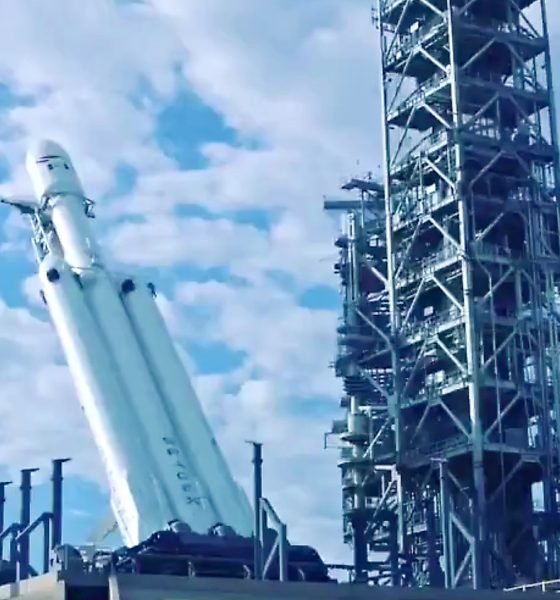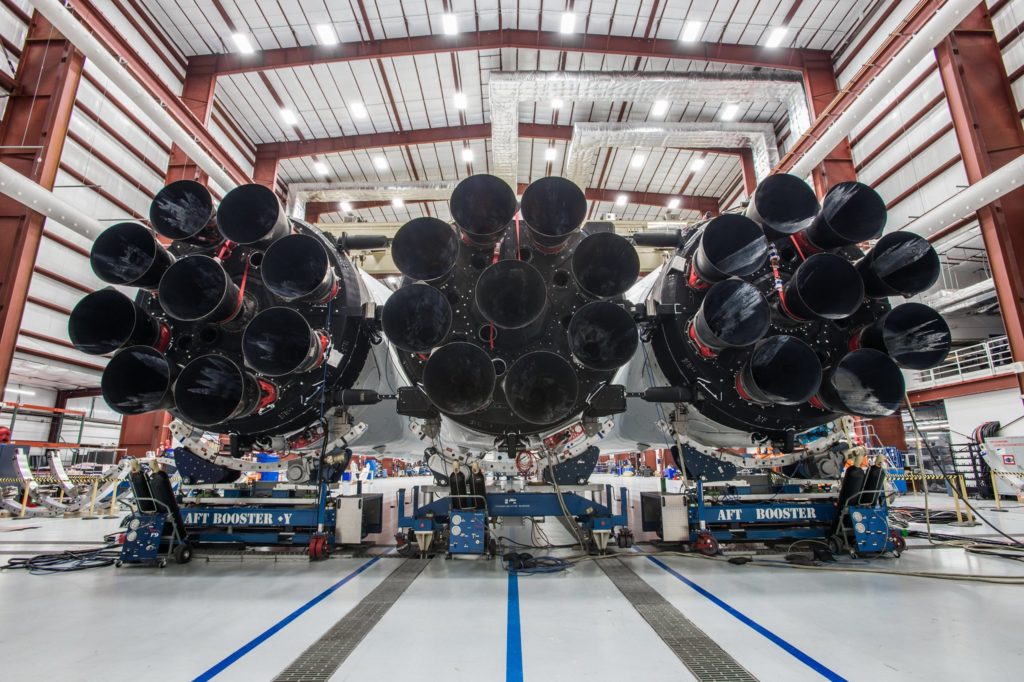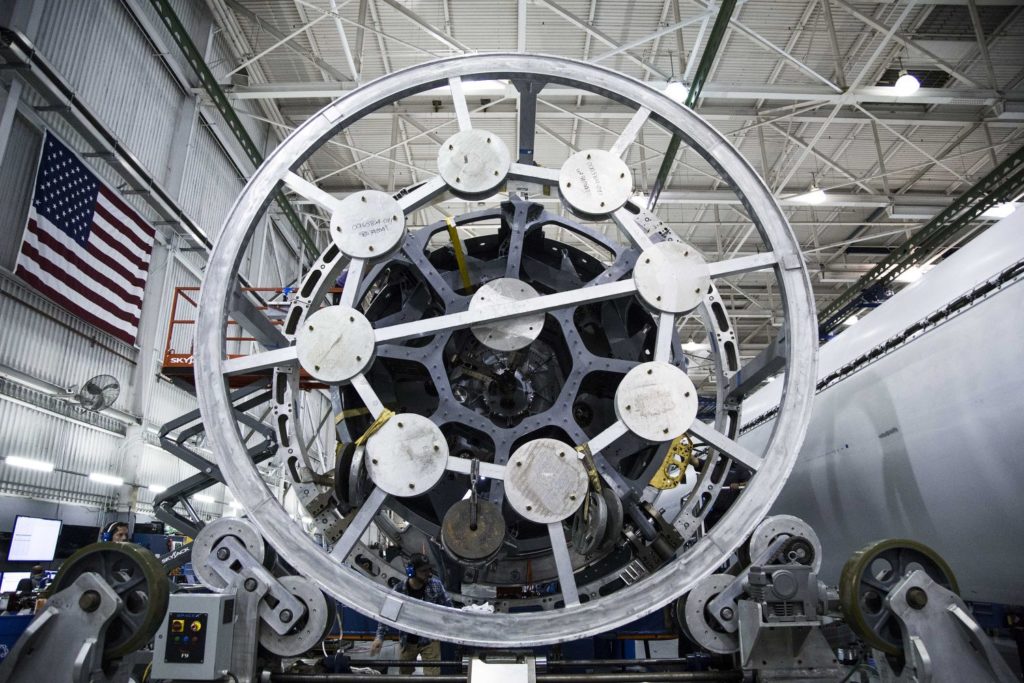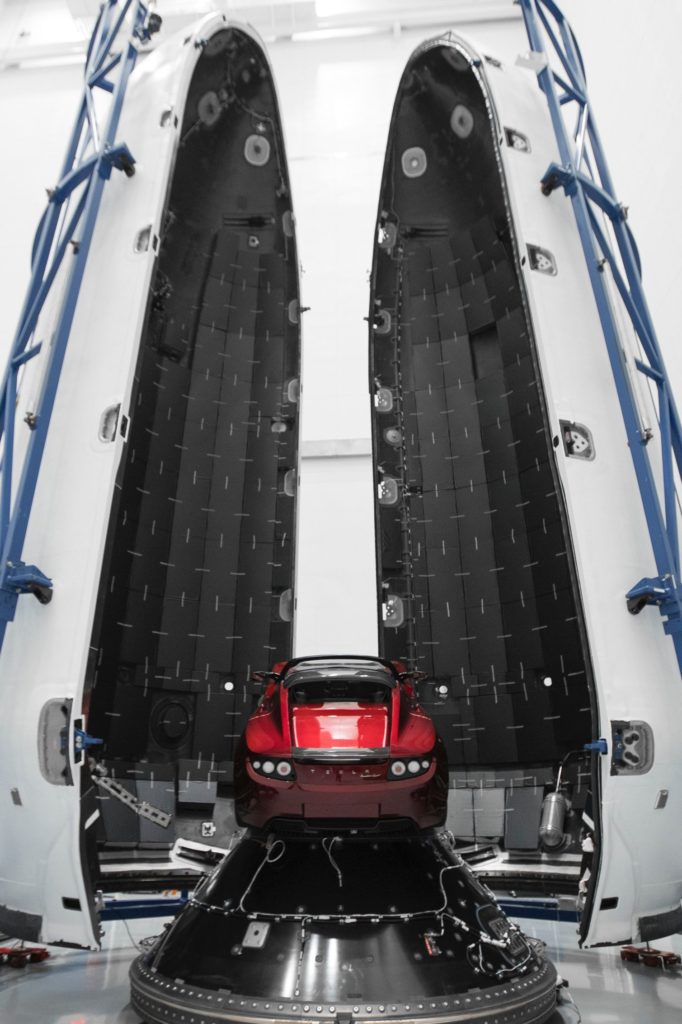

News
Musk shares timelapse of SpaceX Falcon Heavy being raised for launch prep
Elon Musk reiterated SpaceX’s commitment to completing the inaugural launch of Falcon Heavy before the end of January 2018 in a series of Instagram and Twitter posts. Delays with the companies commercial launch of the secretive Zuma payload will likely push Heavy back a similar number of days, but SpaceX still has a solid four weeks until February to prepare the vehicle and complete its more pressing commercial queue of launches.
Up next for Falcon Heavy will be the massive rocket’s first-ever integrated static fire, which will see all 27 of its Merlin 1D engines ignite for a brief several seconds in order to test a number of procedures and validate models of the rocket’s design and operations. Most importantly, in order to counteract the immense and potentially destructive torque produced by the simultaneous startup of 27 rocket engines, the first static fire will test a staggered ignition of all first stage engines, so as to spread out the force exerted upon the vehicle’s octawebs and booster connections. Musk’ Jan. 4 Instagram post points towards a static fire “next week,” sometime between January 8-15. The launch of Zuma is clearly the company’s main priority, at the moment.
https://www.instagram.com/p/BdjBHqdAIzs/?taken-by=elonmusk
- Falcon Heavy’s three boosters and 27 Merlin 1D engines on full display. (SpaceX)
- Falcon 9’s octaweb is shown exposed here in all its hunk-of-raw-metal glory. Falcon Heavy’s center octaweb is even beefier. (SpaceX)
- Elon Musk’s Roadster seen before being encapsulated in Falcon Heavy’s massive payload fairing. Below the Tesla is the payload adapter, which connects it to the rocket. (SpaceX)
Preceding this static fire, SpaceX will necessarily conduct a wet dress rehearsal (WDR) in which Falcon Heavy’s three first stages and single second stage will be fully loaded with supercooled high-grade kerosene (known as RP-1) and liquid oxygen. If this procedure fails to produce any unwanted surprises or insurmountable bugs, it’s probable that the WDR flow will transfer smoothly into static fire procedures. If bugs are found, the vehicle may instead be detanked of its propellant load and rolled back to LC-39A’s integration facilities in order to analyze those issues and ensure vehicle safety and readiness. Similar analysis will undoubtedly occur after the first static fire to verify that Falcon Heavy is still flight-worthy and its Tesla Roadster payload is in good condition.
After several barrages of thorough tests, the launch pad and vehicle will be ready for Falcon Heavy’s inaugural launch, no earlier than late January 2018. In the meantime, antsy fans can bask in the beauty of a timelapse Elon Musk recently posted, showing Falcon Heavy being lifted into a vertical orientation during its first pad-fit checks several days ago.
Falcon Heavy goes vertical pic.twitter.com/uG1k0WISv1
— Elon Musk (@elonmusk) January 5, 2018
Meanwhile, SpaceX is still tracking towards the imminent launch of Zuma, a secretive satellite payload that will see Falcon 9 return to Landing Zone 1 at Cape Canaveral. The mission has been delayed 48 hours from its original NET, and is now tentatively aiming to launch no earlier than (NET) January 6, but as of just a few minutes ago, SpaceX officially confirmed that additional propellant loading tests had been conducted with Zuma’s Falcon 9 booster earlier today, pushing the launch to NET January 7th, 8pm EST.
Team at the Cape completed additional propellant loading tests today. Extreme weather slowed operations but Falcon 9 and the Zuma spacecraft are healthy and go for launch—now targeting January 7 from Pad 40 in Florida.
— SpaceX (@SpaceX) January 5, 2018
Follow along live as our launch photographer Tom Cross braves the Florida cold and launch delays in pursuit of glorious rocket pics over the next several days.

News
Tesla is not sparing any expense in ensuring the Cybercab is safe
Images shared by the longtime watcher showed 16 Cybercab prototypes parked near Giga Texas’ dedicated crash test facility.

The Tesla Cybercab could very well be the safest taxi on the road when it is released and deployed for public use. This was, at least, hinted at by the intensive safety tests that Tesla seems to be putting the autonomous two-seater through at its Giga Texas crash test facility.
Intensive crash tests
As per recent images from longtime Giga Texas watcher and drone operator Joe Tegtmeyer, Tesla seems to be very busy crash testing Cybercab units. Images shared by the longtime watcher showed 16 Cybercab prototypes parked near Giga Texas’ dedicated crash test facility just before the holidays.
Tegtmeyer’s aerial photos showed the prototypes clustered outside the factory’s testing building. Some uncovered Cybercabs showed notable damage and one even had its airbags engaged. With Cybercab production expected to start in about 130 days, it appears that Tesla is very busy ensuring that its autonomous two-seater ends up becoming the safest taxi on public roads.
Prioritizing safety
With no human driver controls, the Cybercab demands exceptional active and passive safety systems to protect occupants in any scenario. Considering Tesla’s reputation, it is then understandable that the company seems to be sparing no expense in ensuring that the Cybercab is as safe as possible.
Tesla’s focus on safety was recently highlighted when the Cybertruck achieved a Top Safety Pick+ rating from the Insurance Institute for Highway Safety (IIHS). This was a notable victory for the Cybertruck as critics have long claimed that the vehicle will be one of, if not the, most unsafe truck on the road due to its appearance. The vehicle’s Top Safety Pick+ rating, if any, simply proved that Tesla never neglects to make its cars as safe as possible, and that definitely includes the Cybercab.
Elon Musk
Tesla’s Elon Musk gives timeframe for FSD’s release in UAE
Provided that Musk’s timeframe proves accurate, FSD would be able to start saturating the Middle East, starting with the UAE, next year.

Tesla CEO Elon Musk stated on Monday that Full Self-Driving (Supervised) could launch in the United Arab Emirates (UAE) as soon as January 2026.
Provided that Musk’s timeframe proves accurate, FSD would be able to start saturating the Middle East, starting with the UAE, next year.
Musk’s estimate
In a post on X, UAE-based political analyst Ahmed Sharif Al Amiri asked Musk when FSD would arrive in the country, quoting an earlier post where the CEO encouraged users to try out FSD for themselves. Musk responded directly to the analyst’s inquiry.
“Hopefully, next month,” Musk wrote. The exchange attracted a lot of attention, with numerous X users sharing their excitement at the idea of FSD being brought to a new country. FSD (Supervised), after all, would likely allow hands-off highway driving, urban navigation, and parking under driver oversight in traffic-heavy cities such as Dubai and Abu Dhabi.
Musk’s comments about FSD’s arrival in the UAE were posted following his visit to the Middle Eastern country. Over the weekend, images were shared online of Musk meeting with UAE Defense Minister, Deputy Prime Minister, and Dubai Crown Prince HH Sheikh Hamdan bin Mohammed. Musk also posted a supportive message about the country, posting “UAE rocks!” on X.
FSD recognition
FSD has been getting quite a lot of support from foreign media outlets. FSD (Supervised) earned high marks from Germany’s largest car magazine, Auto Bild, during a test in Berlin’s challenging urban environment. The demonstration highlighted the system’s ability to handle dense traffic, construction sites, pedestrian crossings, and narrow streets with smooth, confident decision-making.
Journalist Robin Hornig was particularly struck by FSD’s superior perception and tireless attention, stating: “Tesla FSD Supervised sees more than I do. It doesn’t get distracted and never gets tired. I like to think I’m a good driver, but I can’t match this system’s all-around vision. It’s at its best when both work together: my experience and the Tesla’s constant attention.” Only one intervention was needed when the system misread a route, showcasing its maturity while relying on vision-only sensors and over-the-air learning.
News
Tesla quietly flexes FSD’s reliability amid Waymo blackout in San Francisco
“Tesla Robotaxis were unaffected by the SF power outage,” Musk wrote in his post.

Tesla highlighted its Full Self-Driving (Supervised) system’s robustness this week by sharing dashcam footage of a vehicle in FSD navigating pitch-black San Francisco streets during the city’s widespread power outage.
While Waymo’s robotaxis stalled and caused traffic jams, Tesla’s vision-only approach kept operating seamlessly without remote intervention. Elon Musk amplified the clip, highlighting the contrast between the two systems.
Tesla FSD handles total darkness
The @Tesla_AI account posted a video from a Model Y operating on FSD during San Francisco’s blackout. As could be seen in the video, streetlights, traffic signals, and surrounding illumination were completely out, but the vehicle drove confidently and cautiously, just like a proficient human driver.
Musk reposted the clip, adding context to reports of Waymo vehicles struggling in the same conditions. “Tesla Robotaxis were unaffected by the SF power outage,” Musk wrote in his post.
Musk and the Tesla AI team’s posts highlight the idea that FSD operates a lot like any experienced human driver. Since the system does not rely on a variety of sensors and a complicated symphony of factors, vehicles could technically navigate challenging circumstances as they emerge. This definitely seemed to be the case in San Francisco.
Waymo’s blackout struggles
Waymo faced scrutiny after multiple self-driving Jaguar I-PACE taxis stopped functioning during the blackout, blocking lanes, causing traffic jams, and requiring manual retrieval. Videos shared during the power outage showed fleets of Waymo vehicles just stopping in the middle of the road, seemingly confused about what to do when the lights go out.
In a comment, Waymo stated that its vehicles treat nonfunctional signals as four-way stops, but “the sheer scale of the outage led to instances where vehicles remained stationary longer than usual to confirm the state of the affected intersections. This contributed to traffic friction during the height of the congestion.”
A company spokesperson also shared some thoughts about the incidents. “Yesterday’s power outage was a widespread event that caused gridlock across San Francisco, with non-functioning traffic signals and transit disruptions. While the failure of the utility infrastructure was significant, we are committed to ensuring our technology adjusts to traffic flow during such events,” the Waymo spokesperson stated, adding that it is “focused on rapidly integrating the lessons learned from this event, and are committed to earning and maintaining the trust of the communities we serve every day.”











